Accounting Factors and Spatio-Temporal Differences of the Carbon Footprint Factor in China’s Power System
Abstract
1. Introduction
1.1. Deficiencies in Existing Research and Contributions of This Study
1.2. Objectives and Significance of the Study
2. Methods and Data
2.1. Functional Unit and Accounting Scope
- The power system includes both the power generation and transmission and distribution systems, covering the process from power generation, to transmission, to output, as shown in Figure 1. The accounting scope of carbon emissions includes life-cycle emissions from the power generation system, as well as emissions from the infrastructure construction of the transmission and distribution system, SF6 leakage, and emissions from the transmission of electricity across spatial boundaries. The final electricity output refers to the amount of electricity sold by the power system, considering electricity transmission across spatial boundaries and electricity losses.
- Carbon emissions are standardized to carbon dioxide equivalent (CO2e).
- Since energy storage technologies are not yet fully mature and remain in the development phase, with limited reference studies on their carbon footprint, this study does not consider the impact of energy storage on the carbon footprint of the electricity system.
2.2. Accounting Methods
2.2.1. Power System Carbon Footprint Factor
2.2.2. Carbon Emissions
2.2.3. Electricity
2.3. Analytical Methods
2.3.1. Uncertainty Analysis
2.3.2. Differences Analysis
2.4. Data Sources
2.4.1. Activity Data
2.4.2. Emission Factors
3. Results and Analysis
3.1. Usability and Uncertainty Analysis of Accounting Results
3.2. Impact of Newly Added Accounting Elements on the Power System Carbon Footprint Factor and Sensitivity Analysis
3.3. Spatio-Temporal Differences of Carbon Footprint Factors of Power Systems
3.3.1. Time Dimension
3.3.2. Spatial Dimension
3.4. Analysis of the Impact of Power System Carbon Footprint Factor—A Case Study of the Chemical Industry
4. Conclusions
- Regarding the newly added accounting elements: Over the past 18 years, transmission and distribution losses have only fallen below 5% in 2022, yet in that year, 7 provinces still exceeded the 5% threshold. In provincial power systems, carbon emissions from cross-spatial electricity transmission accounted for as much as 71.27% of total emissions, and the relationship between emissions and electricity volume was not proportional. Carbon emissions caused by SF6 gas leakage represented 34.55% of the total emissions from the transmission and distribution system. Based on the above results, none of these three accounting elements should be ignored when calculating the carbon footprint factor of the power system.
- Regarding the temporal variation in the power system carbon footprint factor: On an annual scale, the carbon footprint factor shows a clear downward trend, with a cumulative decline of over 20% and an average annual change of 0.0103 kgCO2e/kWh. On a monthly scale, from 2020 to 2022, the differences in carbon footprint factors across quarters were statistically significant (p = 0.007, 0.039, 0.010), exhibiting a seasonal fluctuation pattern. Based on case study analysis, the impact of seasonal variation in the carbon footprint factor on electricity-related carbon emissions is greater than that of using five-year lagged data. Therefore, it is essential to account for and publish power system carbon footprint factors using quarterly, monthly, or even more refined temporal units.
- Regarding the spatial variation in the power system carbon footprint factor: In 2022, the coefficients of variation for the regional and provincial power system carbon footprint factors were 27.38% and 29.98%, respectively, indicating a moderate level of dispersion. At the same geographic location, the differences between provincial and regional power system carbon footprint factors ranged from −73.98% to 119.95%. When the spatial scope is expanded to the national level, the differences for 20 provinces become even greater than those observed at the regional level.
5. Suggestions
- Strengthen the dynamic monitoring and updating mechanism for power system carbon footprint factors. With the rapid increase in the proportion of clean energy, the evaluation and release cycle of power system carbon footprint factors should be shortened to ensure the timeliness of carbon footprint emissions factors. This can be achieved through technologies such as power automation systems, smart meters, and power communication gateways to enable real-time monitoring of electricity data. These technologies will improve the reliability and immediacy of data acquisition, storage, accounting, and verification. It is recommended that relevant departments establish a dynamic monitoring mechanism and regularly update power system carbon footprint factor data to provide strong support for accurate electricity carbon emissions accounting.
- Provide high-resolution localized power system carbon footprint factors to improve the matching of used electricity and emission factors. On the basis of national-level planning, it is recommended to gradually refine the spatial scope of the power system carbon footprint factor. By establishing a database of regional- and provincial-level power system carbon footprint factors, or even more refined levels, we can provide precise data support for local carbon emissions accounting and policy development. By leveraging advanced technologies such as the Internet of Things, big data, and artificial intelligence, the accurate identification of electricity sources and types should be realized. Based on this information, the most accurate power system carbon footprint factor should be matched to improve the accuracy and reliability of carbon footprint accounting.
- Optimize the accounting methods for power system carbon footprint factors, incorporating key accounting elements such as power transmission losses, cross-regional electricity transmission, and SF6 gas leakage. This will help build a more detailed and refined power system carbon footprint accounting system. Additionally, a comprehensive data collection, storage, and management mechanism should be established to strengthen the collection, storage, and sharing of carbon emissions-related data. This will provide a solid data foundation for accurately accounting for power system carbon footprints.
- In global energy-related greenhouse gas emissions, the share attributed to electricity and heat has remained above 50% over the past two decades. Therefore, improving the accuracy of power system carbon footprint factors at the global level is essential for the precise accounting of electricity-related carbon emissions, which, in turn, enables a clearer assessment of each country’s efforts in power system decarbonization. The calculation method used in this study is based on fundamental power system structures and domestic statistical data, and, thus, can also serve as a reference for other countries.
Author Contributions
Funding
Data Availability Statement
Conflicts of Interest
References
- Li, Y. Peaking Simulation and Regional Reduction Potential of Carbon Emissions in Chinese Power Industry. Ph.D. Thesis, Nanchang University, Nanchang, China, 2024. [Google Scholar]
- Lei, S.; Tong, C.; Xiao, B.; Fan, H. Spatiotemporal distribution and influencing factors of carbon emissions in China’s power industry. Meas. Sci. Technol. 2024, 68, 29–33+70. [Google Scholar]
- Tian, P.; Liang, X.; Guan, Y.; Zhao, Y.; Mao, B.; Xue, T. Life cycle carbon emissions of China’s power grid and transition pathway planning for power generation structure. Adv. Clim. Chang. Res. 2024, 20, 97–106. [Google Scholar]
- ISO 14067:2018; Greenhouse Gases—Carbon Footprint of Products. International Organization for Standardization: Geneva, Switzerland, 2024.
- World Resources Institute. GHG Protocol: Product Standard; World Resources Institute: Washington, DC, USA, 2011. [Google Scholar]
- Yan, Y.; Li, X.; Wang, R.; Zhao, Z.; Jiao, A. Decomposing the carbon footprints of multinational enterprises along global value chains. Struct. Chang. Econ. D 2023, 66, 13–28. [Google Scholar] [CrossRef]
- Wang, Z. Carbon emission factors of China’s power sector objectively reflect the achievements in low-carbon transition. China Environmental News. Available online: https://www.cenews.com.cn/news.html?aid=1190069 (accessed on 9 September 2024).
- Su, N. China clarifies calculation methodology for power sector emission factors for the first time. China Energy News 2014, 10. [Google Scholar] [CrossRef]
- Zou, L. Research on the application status of LCA databases for carbon footprint certification. China Qual. 2023, 92–95. [Google Scholar] [CrossRef]
- Ministry of Ecology and Environment of the People’s Republic of China. Announcement on the Release of 2023 Power Sector Carbon Footprint Factor Data; Ministry of Ecology and Environment of the People’s Republic of China: Beijing, China, 2025.
- Ning, L.; Ren, J.; Zhang, Z.; Cai, B.; Zhou, C. Research on 2020 provincial and regional grid carbon footprints in China. Environ. Eng. 2023, 41, 229–236. [Google Scholar]
- Zhang, Q.; Qiao, K.; Hu, C.; Su, P.; Cheng, O.; Yan, N.; Yan, L. Study on life-cycle carbon emission factors of electricity in China. Int. J. Low-Carbon. Tec. 2024, 19, 2287–2298. [Google Scholar] [CrossRef]
- Li, X.; Li, W.; Dong, Y. Importance of reducing GHG emissions in power transmission and distribution systems. Energy Rep. 2024, 11, 3149–3162. [Google Scholar] [CrossRef]
- Yuan, T.; Zhang, W. A review of research on source-storage-load coordinated planning for new power system. Proc. CSEE 2024, 1–20. [Google Scholar] [CrossRef]
- National Public Service Platform for Standard Information. Greenhouse Gases Product Carbon Footprint Quantification Requirements and Guidelines Released. Available online: https://www.samr.gov.cn/xw/sj/art/2024/art_c178f30369d046bd90f7e969294552d5.html (accessed on 9 September 2024).
- Ministry of Ecology and Environment of the People’s Republic of China. Announcement on the release of CO2 Emission Factors for Electricity in 2021. Available online: https://www.mee.gov.cn/xxgk2018/xxgk/xxgk01/202404/t20240412_1070565.html (accessed on 9 September 2024).
- Ministry of Ecology and Environment of the People’s Republic of China. Baseline Emission Factor for the Regional Power Grid in China for the 2019 Emission Reduction Project. Available online: https://www.mee.gov.cn/ywgz/ydqhbh/wsqtkz/202012/t20201229_815386.shtml (accessed on 9 September 2024).
- National Energy Administration. Blue Book for the Development of New Power Systems. Available online: https://www.nea.gov.cn/2023-06/02/c_1310724249.htm (accessed on 9 September 2024).
- Zhu, J.; Zhou, J.; Zhang, D. Review of full life-cycle carbon footprints accounting of clean energy and power systems. Proc. CSEE 2024, 1–21. [Google Scholar] [CrossRef]
- Sun, Q.; Kong, X.; Chen, Y.; Xiang, T.; Gao, B.; Luo, S. An overview of carbon emission accounting methods for the whole chain of the power system. Autom. Electr. Power Syst. 2024, 1–14. Available online: http://kns.cnki.net/kcms/detail/32.1180.TP.20240410.1325.002.html (accessed on 9 September 2024).
- Chu, J.; Zhou, Y.; Cai, Y.; Wang, X.; Li, C.; Liu, Q. A life-cycle perspective for analyzing carbon neutrality potential of polyethylene terephthalate (PET) plastics in China. J. Clean. Prod. 2022, 330, 129872. [Google Scholar] [CrossRef]
- Tang, C.; Leng, Y.; Wang, P.; Feng, J.; Zhang, S.; Yi, Y.; Li, H.; Tian, S. Study on carbon emissions of a small hydropower plant in Southwest China. Front. Environ. Sci-Switz. 2024, 12, 1462571. [Google Scholar] [CrossRef]
- Xu, Y.; Lu, W.; Wang, Z.; Jia, S.; Wang, H.; Pan, Z. Stochastic simulation of groundwater contamination considering parameter and boundary condition uncertainties. China Environ. Sci. 2022, 42, 3244–3253. [Google Scholar]
- IPCC. Good Practice Guidance and Uncertainty Management in National Greenhouse Gas Inventories; IPCC: Geneva, Switzerland, 2001. [Google Scholar]
- Zhang, L.; Ruiz-Menjivar, J.; Tong, Q.; Zhang, J.; Yue, M. Examining the carbon footprint of rice production and consumption in Hubei, China: A life cycle assessment and uncertainty analysis approach. J. Environ. Manag. 2021, 300, 113698. [Google Scholar] [CrossRef]
- Wei, X.; Tan, X.; Ruan, J.; Lin, M.; Qin, L.; Sun, G.; Xiang, K.; Chu, Y. Research on carbon emission factors of regional and provincial power grids from 2005 to 2021. Adv. Clim. Chang. Res. 2024, 20, 337–350. [Google Scholar]
- National Energy Administration of China. 2021 National Electric Power Reliability Annual Report; National Energy Administration of China: Beijing, China, 2021.
- National Energy Administration of China. 2021 National Electric Power Reliability Annual Report; National Energy Administration of China: Beijing, China, 2022.
- National Energy Administration of China. 2021 National Electric Power Reliability Annual Report; National Energy Administration of China: Beijing, China, 2023.
- China Nuclear Strategic Planning Research Institute; World Nuclear Association. Report on the Operational Performance of the World’s Nuclear Power Plants. Available online: https://nnsa.mee.gov.cn/ywdt/hyzx/202308/t20230816_1038692.html?utm_source=chatgpt.com (accessed on 16 August 2024).
- Global Wind Energy Council. Global Wind Report 2024. Available online: https://www.gwec.net/reports/globalwindreport/2024 (accessed on 5 January 2025).
- Xu, L.; Zhang, S.; Yang, M.; Li, W.; Xu, J. Environmental effects of China’s solar photovoltaic industry during 2011-2016: A life cycle assessment approach. J. Clean Prod. 2018, 170, 310–329. [Google Scholar] [CrossRef]
- Li, H.; Jiang, H.; Dong, K.; Wei, Y.; Liao, H. A comparative analysis of the life cycle environmental emissions from wind and coal power: Evidence from China. J. Clean. Prod. 2020, 248, 119192. [Google Scholar] [CrossRef]
- Zhao, X.; Cai, Q.; Zhang, S.; Luo, K. The substitution of wind power for coal-fired power to realize China’s CO2 emissions reduction targets in 2020 and 2030. Energy 2017, 120, 164–178. [Google Scholar] [CrossRef]
- Yuan, L.; Xu, C. Life Cycle Assessment of low-rank coal utilization for power generation and energy transportation. Energies 2019, 12, 2365. [Google Scholar] [CrossRef]
- Sammarchi, S.; Li, J.; Izikowitz, D.; Yang, Q.; Xu, D. China’s coal power decarbonization via CO2 capture and storage and biomass co-firing: A LCA case study in Inner Mongolia. Energy 2022, 261, 125158. [Google Scholar] [CrossRef]
- Qin, P.; Xu, H.; Liu, M.; Xiao, C.; Forrest, K.E.; Samuelsen, S.; Tarroja, B. Assessing concurrent effects of climate change on hydropower supply, electricity demand, and greenhouse gas emissions in the Upper Yangtze River Basin of China. Appl. Energ. 2020, 279, 115694. [Google Scholar] [CrossRef]
- Wang, L.; Wang, Y.; Du, H.; Zuo, J.; Li, R.Y.M.; Zhou, Z.; Bi, F.; Garvlehn, M.P. A comparative life-cycle assessment of hydro, nuclear and wind power: A China study. Appl. Energ. 2019, 249, 37–45. [Google Scholar] [CrossRef]
- Xia, F.; Song, F. Evaluating the economic impact of wind power development on local economies in China. Energ. Policy 2017, 110, 263–270. [Google Scholar] [CrossRef]
- Peng, Y.; Yang, Q.; Wang, L.; Wang, S.; Li, J.; Zhang, X.; Zhang, S.; Zhao, H.; Zhang, B.; Wang, C.; et al. VOC emissions of coal-fired power plants in China based on life cycle assessment method. Fuel 2021, 292, 120325. [Google Scholar] [CrossRef]
- Wang, J.; Wang, R.; Zhu, Y.; Li, J. Life cycle assessment and environmental cost accounting of coal-fired power generation in China. Energ. Policy 2018, 115, 374–384. [Google Scholar] [CrossRef]
- Liu, Y.; Ren, P.; Zheng, Y.; Gao, F.; Sun, B.; Gong, X. Life cycle assessment and regionalized carbon footprint analysis of hydropower generation. J. Beijing Univ. Technol. 2024, 50, 282–289. [Google Scholar]
- Li, X.; Gui, F.; Li, Q. Can hydropower still be considered a clean energy source compelling evidence from a middle-sized hydropower station in China. Sustainability 2019, 11, 4261. [Google Scholar] [CrossRef]
- Li, Y.; Qin, Y.; Yang, L.; Li, Z.; Lu, L. Estimation and analysis of carbon emissions from the large-and medium-sized reservoirs in the upper reaches of Changjiang River: On the basis of the IPCC National Greenhouse Gas Inventory. J. Lake Sci. 2023, 35, 131–145. [Google Scholar]
- Wang, L. Environmental Effects Evaluation of Power energy in China from the Perspective of Environmental Footprints. Master’s Thesis, Tianjin University, Tianjin, China, 2019. [Google Scholar]
- Jiang, Z.; Pan, Z.; Xing, J.; Yu, F. Greenhouse gas emissions from nuclear power chain life cycle in China. China Environ. Sci. 2015, 35, 3502–3510. [Google Scholar]
- Gao, C.; Zhu, S.; An, N.; Na, H.; You, H.; Gao, C. Comprehensive comparison of multiple renewable power generation methods: A combination analysis of life cycle assessment and ecological footprint. Renew. Sust. Energ. Rev. 2021, 147. [Google Scholar] [CrossRef]
- Gao, C.; Na, H.; Song, K.; Dyer, N.; Tian, F.; Xu, Q.; Xing, Y. Environmental impact analysis of power generation from biomass and wind farms in different locations. Renew. Sust. Energ. Rev. 2019, 102, 307–317. [Google Scholar] [CrossRef]
- Du, Y.; Huang, H.; Liu, H.; Zhao, J.; Yang, Q. Life cycle assessment of abandonment of onshore wind power for hydrogen production in China. Sustainability 2024, 16, 5772. [Google Scholar] [CrossRef]
- Fu, Y. Life Cycle Assessment of Multi-Crystalline Silicon Photovoltaic System in China. Master’s Thesis, Nanjing University, Nanjing, China, 2013. [Google Scholar]
- Hu, J. Research on Carbon Emission of Photovoltaic Generation with Life Cycle Assessment. Master’s Thesis, Nanjing University of Aeronautics and Astronautics, Nanjing, China, 2017. [Google Scholar]
- Li, Y. Life Cycle Assessment of Crystalline Silicon Modules in China. Master’s Thesis, Shanghai Jiao Tong University, Shanghai, China, 2015. [Google Scholar]
- Li, Y.; Yu, S. Life cycle assessment of photovoltaic sysstem in China. Environ. Eng. 2014, 32, 119–124. [Google Scholar]
- Guo, X.; Dong, Y.; Ren, D. CO2 emission reduction effect of photovoltaic industry through 2060 in China. Energy 2023, 269, 126692. [Google Scholar] [CrossRef]
- Ding, N.; Pan, J.; Liu, J.; Yang, J. An optimization method for energy structures based on life cycle assessment and its application to the power grid in China. J. Environ. Manag. 2019, 238, 18–24. [Google Scholar] [CrossRef]
- China Products Carbon Footprint Factors Database (CPCD). Available online: https://lca.cityghg.com/ (accessed on 7 January 2025).
- IRENA (International Renewable Energy Agency). Available online: https://www.irena.org/ (accessed on 7 January 2025).
- Silk Road Impression Korea Division. Report on Investment Outlook and Risk Forecast for North Korea’s Energy Industry in the Post-Epidemic Era, 2026–2031. Available online: https://www.zcqtz.com/KP/nydl/235956.html (accessed on 30 January 2014).
- Comprehensive Economic and Industry Data (CEIC). Available online: https://www.ceicdata.com.cn/zh-hans (accessed on 7 January 2025).
- Wang, Y.; Zhou, S.; Yao, Z.; Ou, X. Modeling of life-cycle CO2 and air pollutant emission interactions of coal power generation in China. Electr. Power 2021, 54, 128–135. [Google Scholar]
- Zhang, Y.; Dong, X.; Wang, X.; Zhang, P.; Liu, M.; Zhang, Y.; Xiao, R. The relationship between the low carbon industrial model and human well-being: A case study of the electric power industry. Energies 2023, 16, 1357. [Google Scholar] [CrossRef]
- Huang, Y.; Liu, Y.; Xu, W.; Li, J. Life cycle carbon emissions of water reservoir and hydroelectric projects: A case study of the Quanmutang project. J. Tsinghua Univ. Sci. Technol. 2022, 62, 1366–1373. [Google Scholar]
- International Hydropower Association. 2018 Hydropower Status Report. Available online: https://www.hydropower.org/publications/2018-hydropower-status-report. (accessed on 9 September 2024).
- Mu, X.; Xu, Q.; Liu, Y.; Hu, G. Environmental effect analysis of nuclear power based on life cycle assessment. J. Saf. Environ. 2022, 22, 2775–2781. [Google Scholar]
- Liu, P.; Liu, L.; Xu, X.; Zhao, Y.; Niu, J.; Zhang, Q. Carbon footprint and carbon emission intensity of grassland wind farms in Inner Mongolia. J. Clean. Prod. 2021, 313, 127878. [Google Scholar] [CrossRef]
- Zhang, J.; Zhu, G. Comparative studies of photovoltaic power generation and coal-fired power generation base on life cycle assessment. Environ. Sci. Manag. 2014, 39, 86–90. [Google Scholar]
- Liao, X.; Tan, Q.; Zhang, W.; Ma, X.; Ji, J. Analysis of life cycle greenhouse gas emission reduction potentialand cost for China’s power generation sector. Acta Sci. Nat. Univ. Pekin. 2013, 49, 885–891. [Google Scholar]
- Song, X.; Du, S.; Deng, C.; Xie, M.; Shen, P.; Zhao, C.; Chen, C.; Liu, X. Life cycle carbon emission accounting and reduction potential assessment for the iron and steel industry. Environ. Sci. 2023, 44, 6630–6642. [Google Scholar]
- Zhang, X.; Zhuang, G.; Liu, J. Uncertainty analysis of urban greenhouse gas inventories. J. Environ. Econ. 2018, 3, 8–18+149. [Google Scholar]
- Li, H.; Li, L.; Chen, M.; Li, X.; Zhang, K.; Pan, S.; Fan, X.; Yang, Z.; Zou, Z. Safety evaluation of ventilation system on indoor gas insulated switchgear. Power Syst. Big Data 2016, 19, 25–27+32. [Google Scholar]
- Simmonds, P.G.; Rigby, M.; Manning, A.J.; Park, S.; Stanley, K.M.; McCulloch, A.; Henne, S.; Graziosi, F.; Maione, M.; Arduini, J.; et al. The increasing atmospheric burden of the greenhouse gas sulfur hexafluoride. Atmos. Chem. Phys. 2020, 20, 7271–7290. [Google Scholar] [CrossRef]
- Billen, P.; Maes, B.; Larrain, M.; Braet, J. Replacing SF6 in electrical gas insulated switchgear: Technological alternatives and potential life cycle greenhouse gas savings in an EU-28 perspective. Energies 2020, 13, 1807. [Google Scholar] [CrossRef]
- Lv, Z.; Xidao, X. Sulfur hexafluoride: A forgotten greenhouse gas. China Strateg. Emerg. Ind. 2014, 82–84. [Google Scholar] [CrossRef]
- Dai, J. The design of SF6 das state monitoring system of high voltage circuit breaker. Master’s Thesis, Dalian University of Technology, Dalian, China, 2018. [Google Scholar]
- Liu, C. Research and development of online monitoring technology for gil fault gas. Master’s Thesis, Southwest Jiaotong University, Chengdu, China, 2017. [Google Scholar]
- Zhang, Z. Design and implementation of distributed GISD is tribution room gas safety monitoring system. Master’s Thesis, Hangzhou Dianzi University, Hangzhou, China, 2023. [Google Scholar]
- Zhang, Z.; Wang, D.; Wu, X.; Wu, X.; Li, T.; Zheng, Z.; He, J.; Liu, L.; Zang, S. Distribution characteristics of soil carbon at different depths in permafrost regions of the Greater Khingan Mountains. Sci. Geogr. Sin. 2024, 44, 534–542. [Google Scholar]
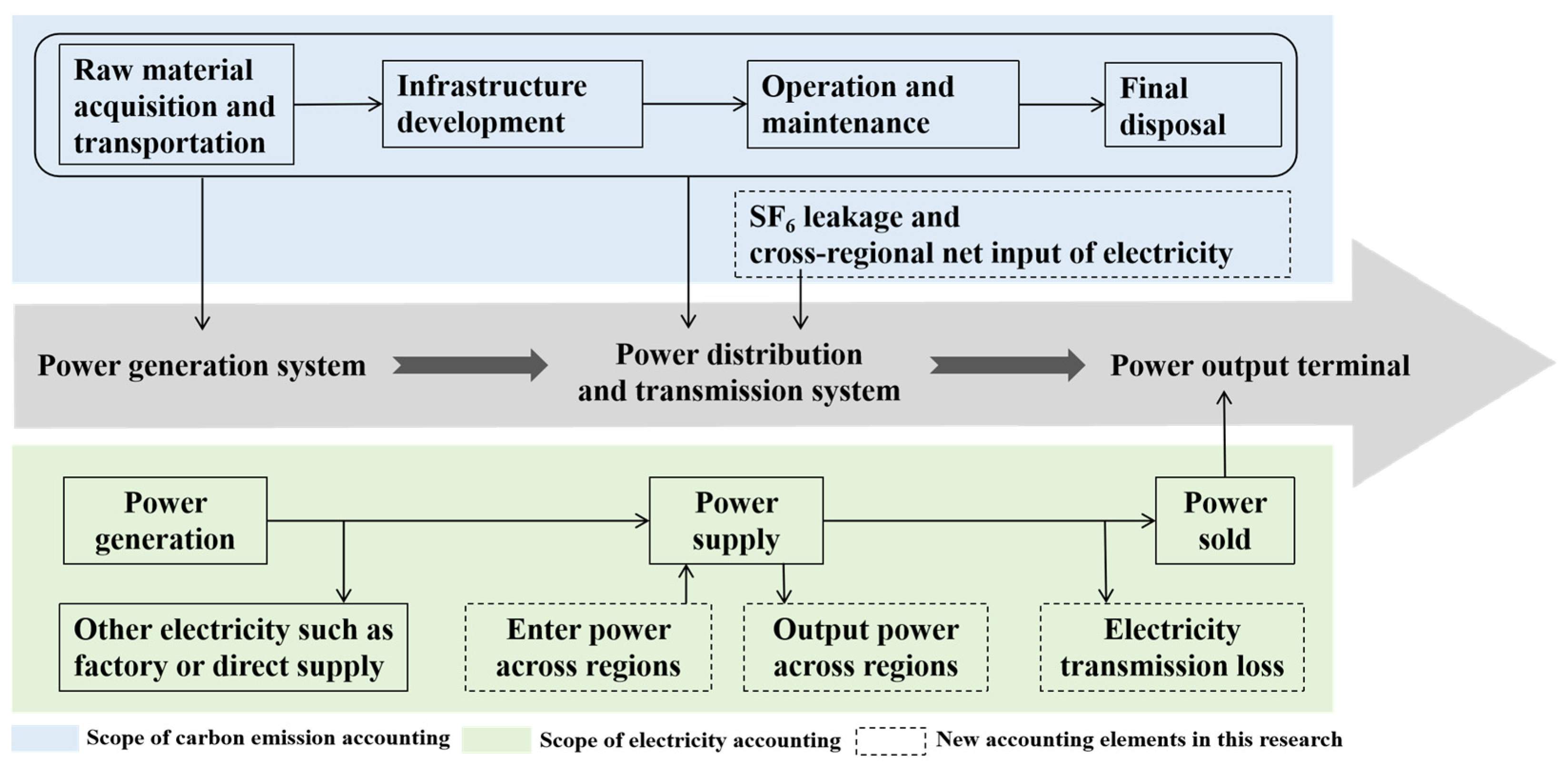

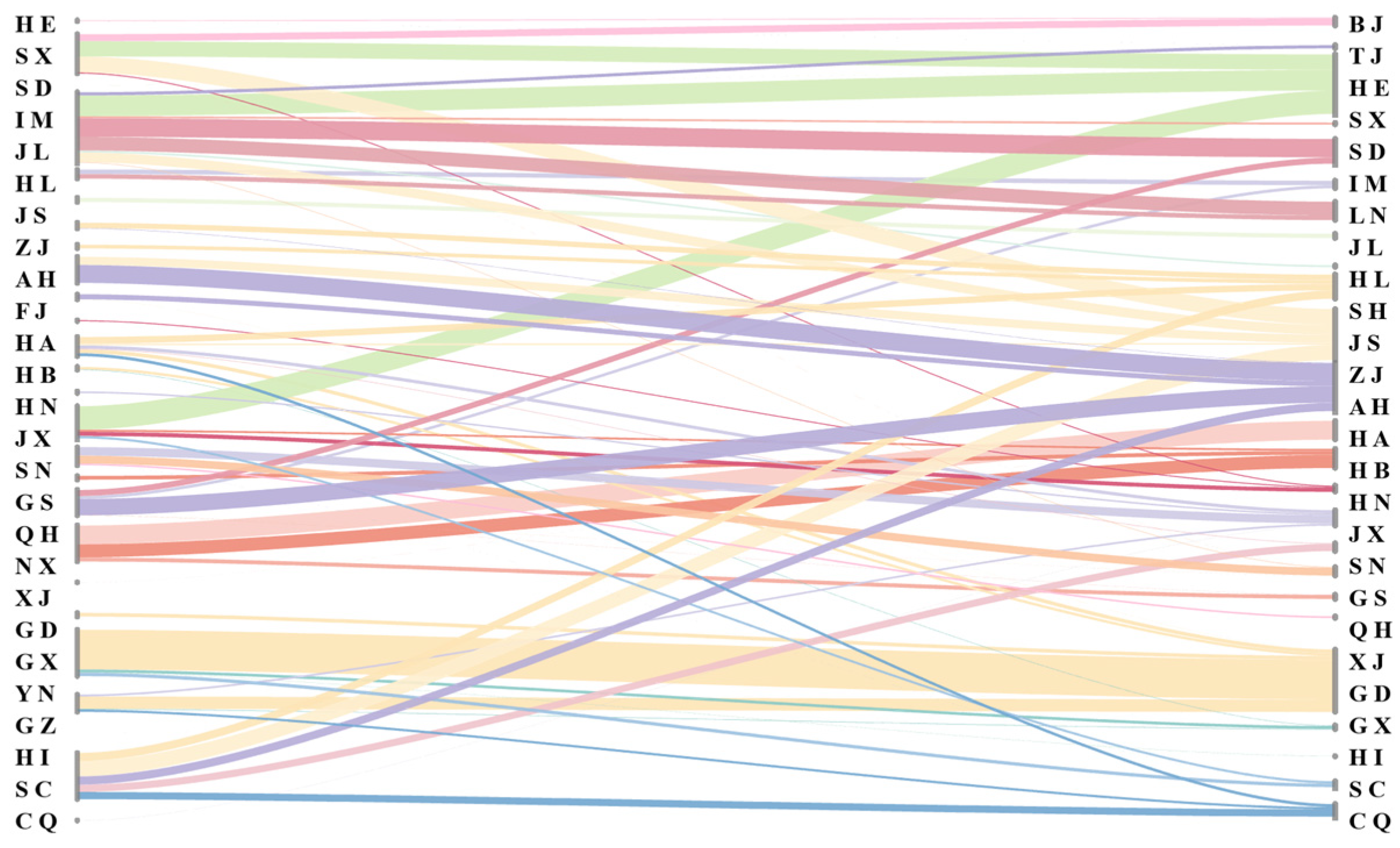

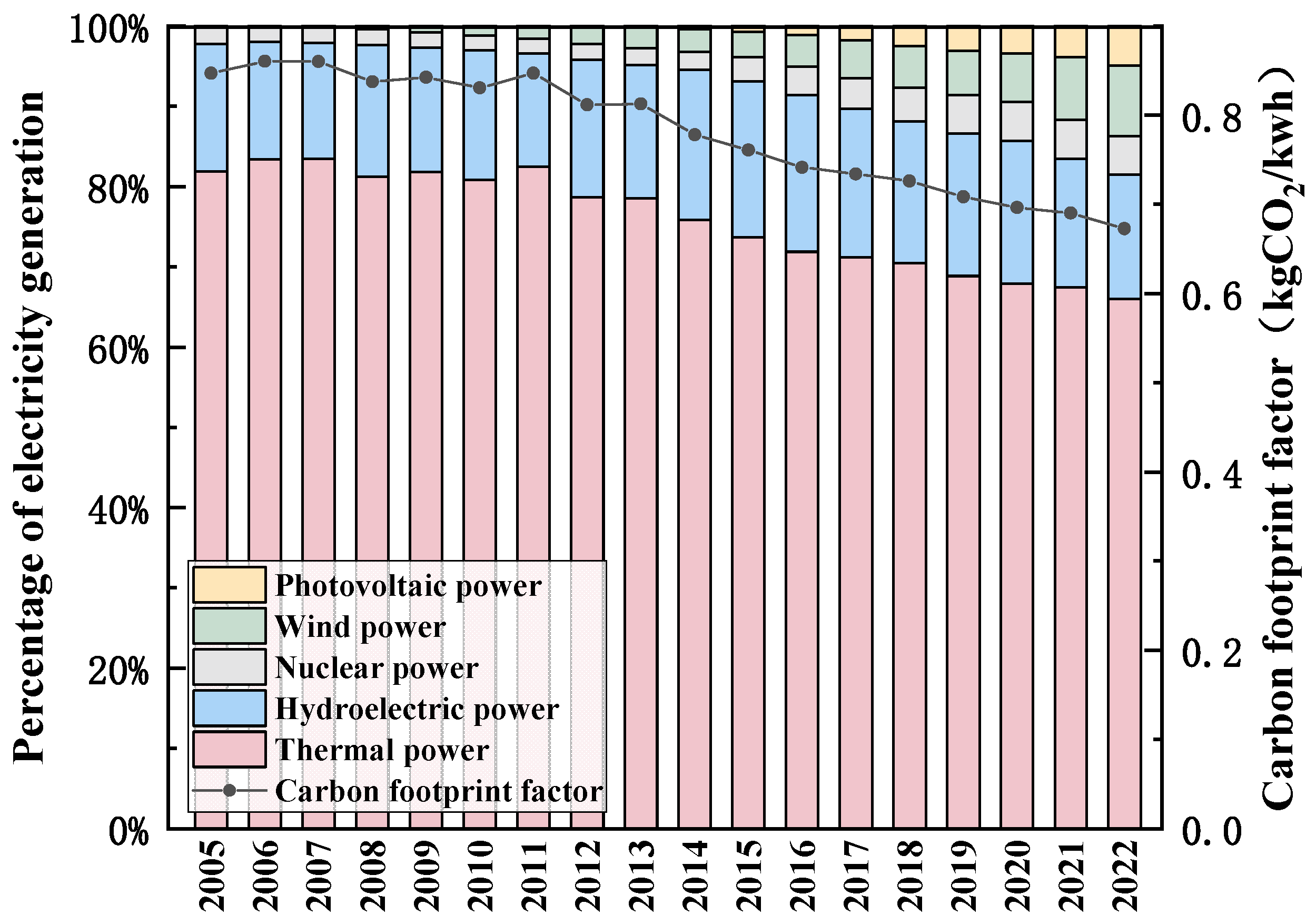

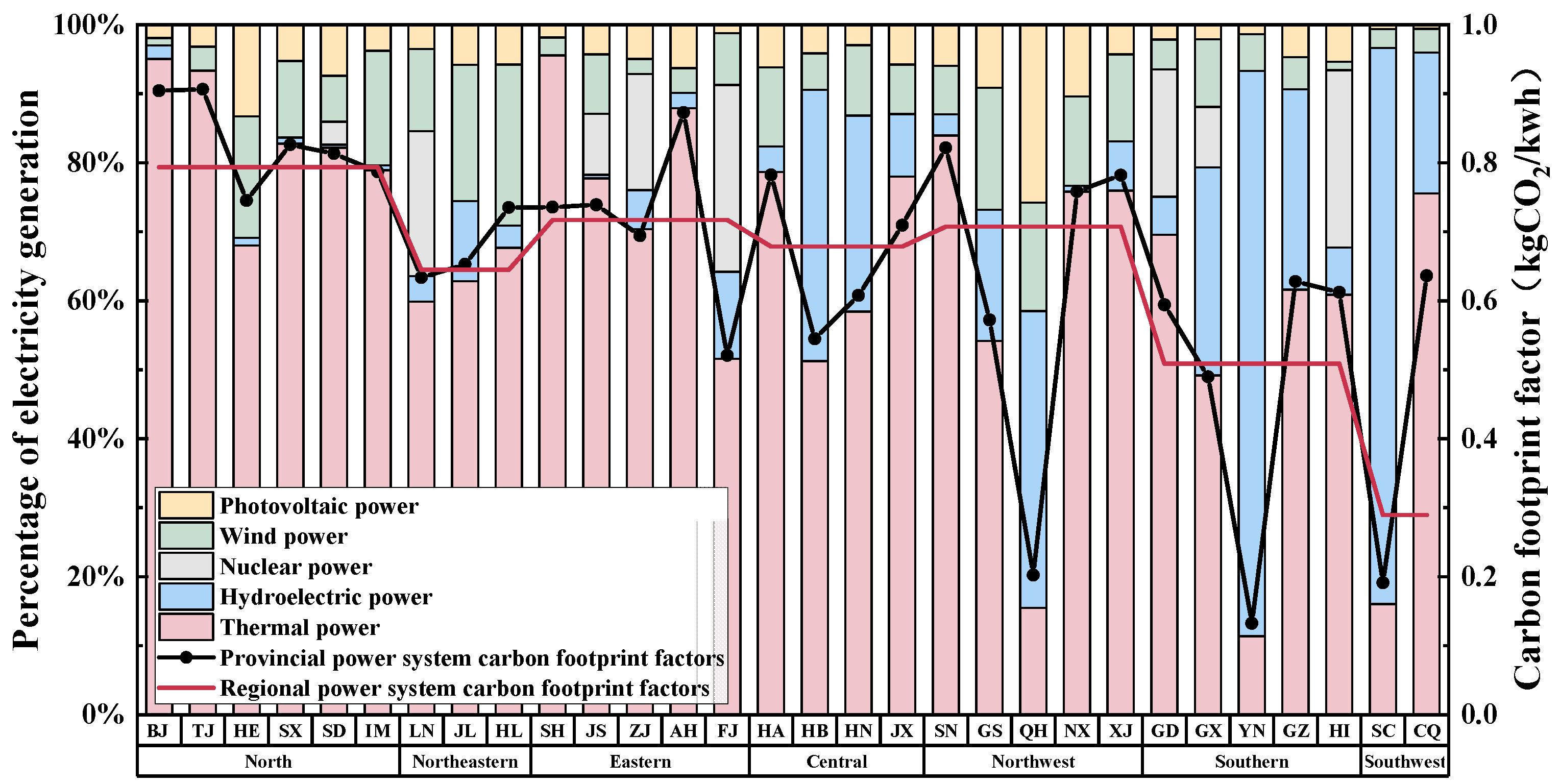
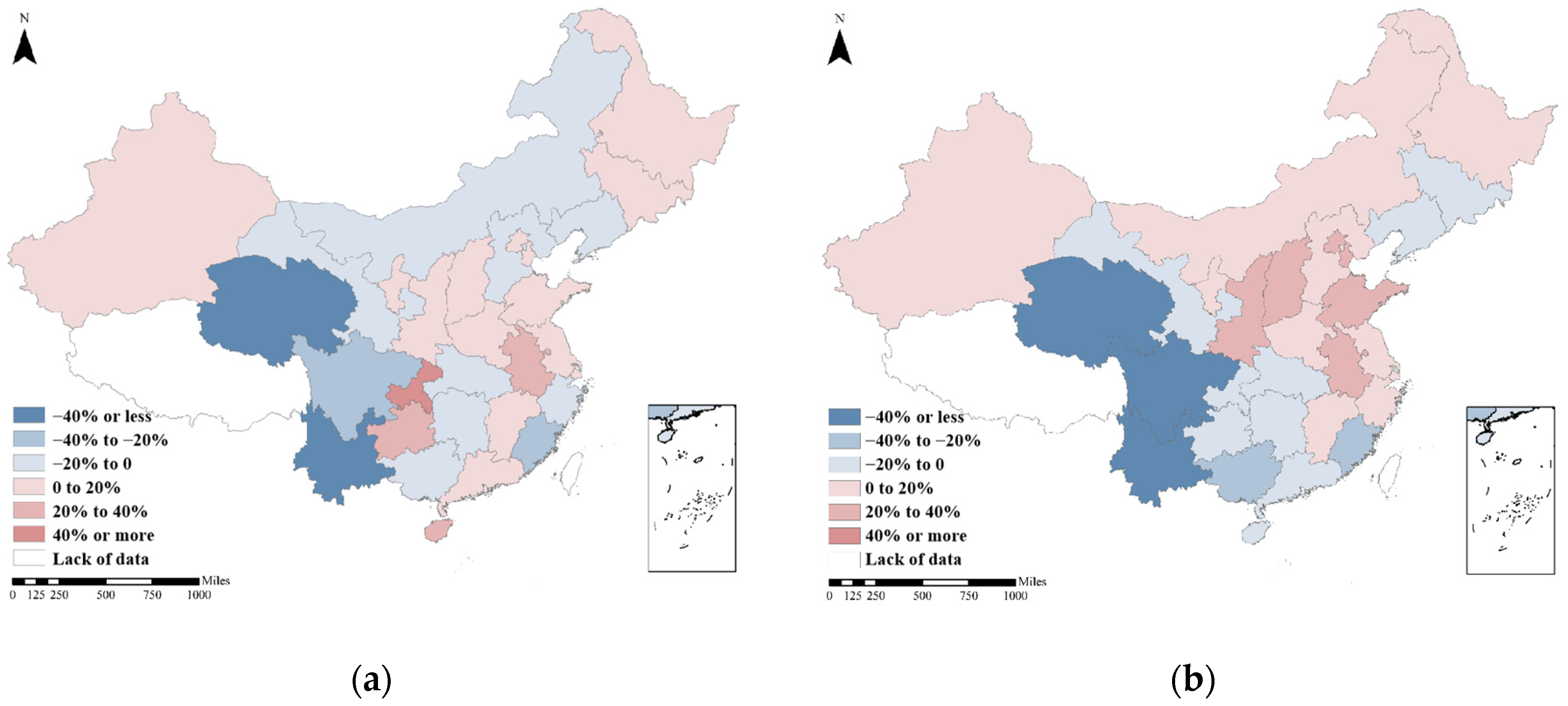

| Research | Methods | Power System Spatial Scope | Data Years | Accounting Scope | Gaps |
|---|---|---|---|---|---|
| MEE [11] | Formula method | National | 2023 | Life-cycle emissions of power generation system and transmission and distribution system infrastructure | Single spatial scope, incomplete accounting scope of transmission and distribution system, and failure to account for line losses |
| Ning et al. [12] | Emission factor method | Regional, provincial | 2020 | Direct emissions from thermal power generation, life-cycle emissions of renewable energy power generation, cross-spatial transmission power emissions, and power losses | Non-full life cycle of the power generation process, and emissions from renewable energy power generation sourced from databases |
| Tian et al. [3] | Emission factor method | National, regional, provincial | National: 2011–2021, regional, provincial: 2021 | Life-cycle emissions of power generation system | Exclusion of the transmission and distribution system |
| Zhang et al. [13] | Emission factor method | National | 2021 | Life-cycle emissions of power generation system | Single spatial scope, exclusion of the transmission and distribution system |
| Li et al. [14] | Emission factor method | National | none | Life-cycle emissions of transmission and distribution system (including infrastructure construction, SF6 leakage, and power losses) | Exclusion of the power generation system |
| This work | Emission factor method | National, regional, provincial | National: 2005–2022, regional, provincial: 2022. Temporal precision refined to a monthly scale | Life-cycle emissions of power generation system and transmission and distribution system (including infrastructure construction, SF6 leakage, and power losses), cross-spatial transmission power emissions, and power losses | Exclusion of the impact of energy storage technologies |
| Regional Power Grid | Coverage Area |
|---|---|
| North | Beijing, Tianjin, Hebei, Shanxi, Shandong, Inner Mongolia. |
| Northeastern | Liaoning, Jilin, Heilongjiang |
| Eastern | Shanghai, Jiangsu, Zhejiang, Anhui, Fujian. |
| Central | Henan, Hubei, Hunan, Jiangxi. |
| Northwest | Shaanxi, Gansu, Qinghai, Ningxia, Xinjiang. |
| Southern | Guangdong, Guangxi, Yunnan, Guizhou, Hainan. |
| Southwest | Sichuan, Chongqing. |
| Power Supply Type | Type of Representation | Reason |
|---|---|---|
| Thermal power | Coal-fired unit | Coal-fired units account for 92.38%, 92.08%, and 92.08% of the installed capacity of thermal power units in 2021, 2022, and 2023, respectively [27,28,29]. |
| Hydroelectric power | Francis turbine | Francis turbine units account for 81.09%, 90.08%, and 78.47% of the installed capacity of hydroelectric power units in 2021, 2022, and 2023, respectively [27,28,29]. |
| Nuclear power | Pressurized water reactor unit | Pressurized water reactors account for more than 70% of all operable reactors in China [30]. |
| Wind power | 1.5 MW wind turbine | 1.5 MW wind turbines are the most common type of wind turbine in the Chinese wind power market [31]. |
| Photovoltaic power | Multicrystalline silicon solar cell | The environmental impact of polycrystalline and monocrystalline solar photovoltaic products does not differ much, but studies related to the carbon footprint of polycrystalline silicon are more mature [32]. |
| Transmission and distribution system | National average power grid | The national average power grid represents the average level of China’s transmission and distribution system. |
| Data Name | Data Sources |
|---|---|
| Thermal power | [33,34,35,36,37,38,39,40,41] |
| Hydroelectric power | [42,43,44] |
| Nuclear power | [45,46] |
| Wind power | [38,47,48,49] |
| Photovoltaic power | [50,51,52,53,54] |
| Grid infrastructure development and SF6 leakage | [13,55] |
| Power Supply Type | Existing Research (kgCO2e/kWh) | Ministry of Ecology and Environment (kgCO2e/kWh) | This Study (kgCO2e/kWh) |
|---|---|---|---|
| Thermal power | 0.8336 [60], 0.9734 [61] | 0.9440 | 0.9509 |
| Hydroelectric power | 0.0128 [62], 0.0185 [63] | 0.0143 | 0.0148 |
| Nuclear power | 0.0034 [64], 0.0124 [38] | 0.0065 | 0.0071 |
| Wind power | 0.0066 [65], 0.0314 [33] | 0.0336 | 0.0305 |
| Photovoltaic power | 0.0288 [66], 0.0500 [67] | 0.0545 | 0.0517 |
| Transmission and distribution systems Infrastructure development | 0.0018 [13] | 0.0036 | 0.0019 |
| SF6 leakage | 0.0018 | none | 0.0019 |
| Carbon Emission Sources | Uncertainty |
|---|---|
| Thermal power | 10.79% |
| Hydroelectric power | 8.89% |
| Nuclear power | 7.62% |
| Wind power | 7.83% |
| Photovoltaic power | 11.91% |
| Transmission and distribution system (including infrastructure and SF6 leakage) | 6.47% |
Disclaimer/Publisher’s Note: The statements, opinions and data contained in all publications are solely those of the individual author(s) and contributor(s) and not of MDPI and/or the editor(s). MDPI and/or the editor(s) disclaim responsibility for any injury to people or property resulting from any ideas, methods, instructions or products referred to in the content. |
© 2025 by the authors. Licensee MDPI, Basel, Switzerland. This article is an open access article distributed under the terms and conditions of the Creative Commons Attribution (CC BY) license (https://creativecommons.org/licenses/by/4.0/).
Share and Cite
Li, A.; Wang, Z.; Sun, X.; Ma, F. Accounting Factors and Spatio-Temporal Differences of the Carbon Footprint Factor in China’s Power System. Energies 2025, 18, 2663. https://doi.org/10.3390/en18102663
Li A, Wang Z, Sun X, Ma F. Accounting Factors and Spatio-Temporal Differences of the Carbon Footprint Factor in China’s Power System. Energies. 2025; 18(10):2663. https://doi.org/10.3390/en18102663
Chicago/Turabian StyleLi, Ao, Zhen Wang, Xingyu Sun, and Fei Ma. 2025. "Accounting Factors and Spatio-Temporal Differences of the Carbon Footprint Factor in China’s Power System" Energies 18, no. 10: 2663. https://doi.org/10.3390/en18102663
APA StyleLi, A., Wang, Z., Sun, X., & Ma, F. (2025). Accounting Factors and Spatio-Temporal Differences of the Carbon Footprint Factor in China’s Power System. Energies, 18(10), 2663. https://doi.org/10.3390/en18102663






